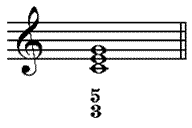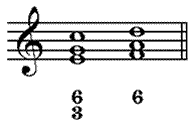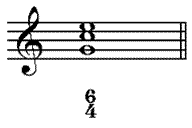Reference : figured bass triad symbols
The principle of basso continuo, or figured bass, is simple: We use figures to indicate the intervals we want to add above a given bass. The notes retain the accidentals of the key. This allows the same chord symbols to be used for different types of triads. For example, a triad in the root position is indicated by the numbers 5 (fifth) and 3 (third):

Root Position
However, to avoid using too many symbols, which would make the music difficult to read, we will assume that a chord is a root triad if there is no symbol underneath it. In the next example, all basses without symbols will be harmonized with root triads:

Some schools use the symbol ![]() for the VII degree chord to indicate that it is a chord with a diminished fifth chord.
for the VII degree chord to indicate that it is a chord with a diminished fifth chord.
First Inversion
In the first inversion we use 6 and 3. But usually it is simplified by using only the 6. That is why we call these chords sixth chords:

Second Inversion
In the second inversion we use 6 and 4 and don't simplify the symbol. These chords are known as six-four chords.

